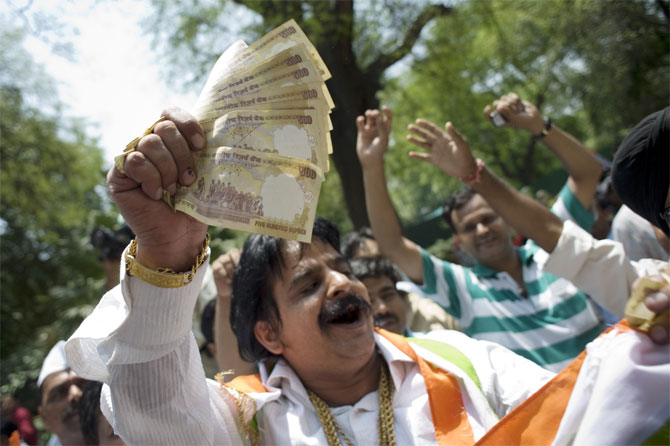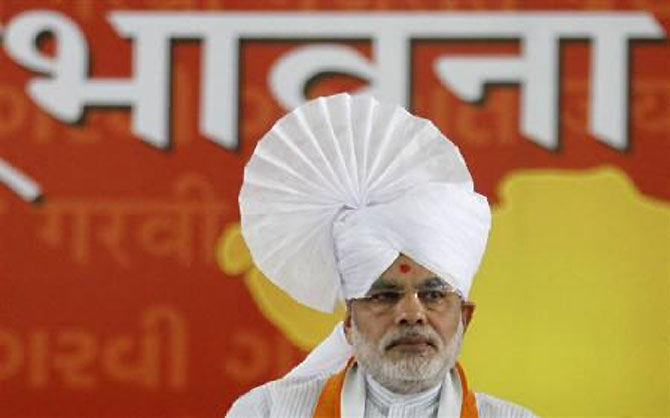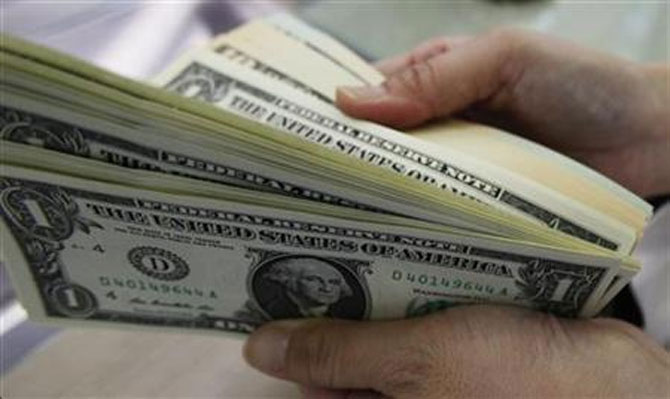
Mr Modi should welcome the rupee’s fall as overdue, not criticise it.
The external value of the rupee has become a matter of political debate, which is fine. What is not fine is that positions should be taken on the basis of historical fiction.
It is bad enough that Narendra Modi, the Bharatiya Janata Party’s (BJP’s) all-but-formal candidate for prime minister next year, should articulate more than once the mythical “fact” that has been floating around in the cyber world that the rupee was equal to a US dollar in 1947.
That supposed parity has subsequently found its way into some newspaper articles, and was repeated by parliamentarians taking part in a Rajya Sabha debate last week.
The regret is that the finance minister, who should have known better, gave this mythical rupee-dollar parity new life by confirming it as fact (“Of course, it was in 1947 that one rupee was indeed equal to one dollar”).
For the record, the rupee was never equal to the dollar, except perhaps in the hoary past. At the time of independence, India’s currency was pegged to pound sterling, and the exchange rate was a shilling and six pence for a rupee — which worked out to Rs 13.33 to the pound.
The dollar-pound exchange rate then was $4.03 to the pound, which in effect gave a rupee-dollar rate in 1947 of around Rs 3.30. The pound was devalued in 1949, changing its dollar parity from 4.03 to 2.80.
India was then a part of the sterling area, and the rupee was devalued on the same day by the same percentage, so that the new dollar exchange rate in 1949 became Rs 4.76 — which is where it stayed till the rupee devaluation of 1966 made it Rs 7.50 to the dollar and the pound moved to Rs 21.
Read on for Finance Minister's comments...

The BJP has made currency value a political issue because it wants to argue that the currency’s decline testifies to poor economic management by the government.
Currency value does of course denote economic strength (China’s yuan, for instance, has been appreciating in value in recent years), but the worst outcome of the debate would be to reverse cause and effect and posit that a strong currency would somehow make India economically strong.
As Mr Chidambaram has done well to point out in the Rajya Sabha, the debate on the currency “should not become a debate about the pride or prestige of our country… We have to address the fundamental issues … [the] fiscal deficit and the current account deficit”. Indeed, most countries that grew rapidly in the past did so by deliberately undervaluing their currencies, as China too did until fairly recently.
In historical terms, the rupee’s fall during the life of the two United Progressive Alliance governments taken together (from Rs 45 to Rs 62 for the dollar) is par for the course.
Indeed, the current account deficit has grown to gargantuan proportions in recent years precisely because the rupee-dollar rate was the same in 2000 as well as in 2010.
With higher inflation rates in India than in all developed and many developing markets and a currency that did not depreciate to reflect the inflation differential, Indian exports simply became uncompetitive.
The correction in the rupee value gives exporters a new lease of life. If he understands economics, Mr Modi should welcome the rupee’s fall as overdue, not criticise it. If the BJP wants a strong India, it should demand a weak currency.
Click on NEXT for the excerpt from Finance Minister P Chidambaram’s reply on a call attention motion on the state of the economy, Rajya Sabha, August 14, 2013...

'Don't get carried away by what you read about the rupee'
Sir, the last point I want to make is on the rupee. I have seen so much writing about the rupee in the last several days. I think, they have to go back to the drawing board to understand what the rupee is and how the rupee behaves. Yes, people have said that one rupee is equal to one dollar. Of course, it was in 1947 that one rupee was indeed equal to one dollar. Ten grams of gold cost Rs 88.62 in 1947. Today, ten grams of gold is about Rs 29,000.
The rupee has depreciated. Do you not like the rupee? Don’t take the rupee. I will give you $88. Please go and buy 10 grams of gold today. We will give you $88 if you don’t like it. Please go and buy 10 grams of gold today.
If the rupee has depreciated against the dollar, the dollar has depreciated against gold. Why? It is because in 1947 and earlier, nobody bought gold, there was no demand for gold. The per capita income was low. Wealth was concentrated in a few hands. There was nobody buying gold. There was a certain amount of gold supply and the demand was a certain demand and gold was available at that price.
But, today, the supply of gold may have increased a little more or may have decreased, I don’t know. The demand has increased; more and more people worldwide, not only in India, but all over the world, are buying gold.
In China, too, they are buying as much gold. Despite 50 years of communism, they are not able to desist. They are the people who were away from the attachment to gold.
So, China is buying gold, India is buying gold and gold is today Rs 30,000 per 10 grams. I don’t think we should look at what was the dollar and what was the rupee. I have got the figures on how the rupee behaved for the last ten years. ... Gold standard was removed before 1947. We are talking about 1947 and thereafter.
Click on NEXT for more...

Because you say that the rupee was one dollar in 1947. I am trying to answer that argument. If one rupee was one dollar and the dollar was such a strong currency, do your arithmetic; at $88 you should be able to buy 10 grams of gold today.
The point is, how has the rupee behaved in the last few years. I think, we need to look at that. I will tell you. Sir, the rupee was, in April, 2004, Rs 43.77 to the dollar. In April, 2010, it was Rs 44.77 a dollar.
The rupee was remarkably stable during 2004-2010. Between August, 2011 and August, 2012, the rupee depreciated from Rs 44 to about Rs 55. That is when the Euro Zone crisis hit the world. From 1st August, 2012, to 22nd May, 2013, the rupee was remarkably stable.
It was about Rs 54-Rs 55 to the dollar. For full ten and a half months, the rupee was remarkably stable. Then came the US Fed Chairman’s famous statement, “All currencies in the world depreciated because of a hint that quantitative easing will be withdrawn.”
Sir, it is not as though the Indian rupee alone is affected. I was patting myself on the back thinking that in another six weeks I could claim that the rupee has been remarkably stable for one year.
But, then came the statement. Every currency has depreciated. In fact, the rupee’s depreciation is smaller than the depreciation of some other currencies and worse than the depreciation of some currencies.
Click on NEXT for more...

The point is, given our inflation, given our fiscal deficit, given our current account deficit, there will be some pressure on the rupee and the rupee will indeed depreciate a little. All that we are saying is, we can’t allow the rupee to go into a free fall. We are not arguing for and against a strong rupee.
We are arguing for a stable rupee. We cannot allow the currency market to be destabilised or the currency market to be volatile. So, the measures that we are taking are to reduce the volatility in the currency market, to quell speculation in the currency market so that the rupee is stable.
But the rupee must indeed find a level given the demand and supply and given the objective financial conditions. But if our fiscal consolidation takes place at a rapid pace, if we are able to contain the fiscal deficit, and if we are able to carry conviction to the world that we will contain the current account deficit and finance it safely and if the flows return to India, you will find the rupee is strengthened.
It is not as though the rupee has not strengthened in the past. For example, in April, 2009, the rupee had hit 50. But by April, 2010, it had strengthened to 44. Therefore, my respectful request is: please don’t get carried away by what you read and what you hear about the rupee. The rupee will find its level, but we try to do what has to be done to keep the economy stable and growing; the rupee will find its correct level.
Nobody can predict what the correct level is. It depends upon the objective economic conditions and the demand and supply for foreign currency. Suppose, our exports improve dramatically; suppose we are able to reduce our dependence on oil which is imported or coal which is imported, it will change. Hence, it will change overnight.
Therefore, my respectful submission is, while the debate on the rupee is a welcome debate, it should not become a debate about the pride or prestige of our country. Yes, we all want a stable currency, we also want a currency that has a high purchasing power, but we have to address the fundamental issues. The fundamental issues are fiscal deficit and the current account deficit.
These are being addressed, and as we address these issues, I assure this House, we will find that the country’s economy becomes stable, more strong and we become more prosperous.
Excerpt from Finance Minister P Chidambaram’s reply on a call attention motion on the state of the economy, Rajya Sabha, August 14, 2013